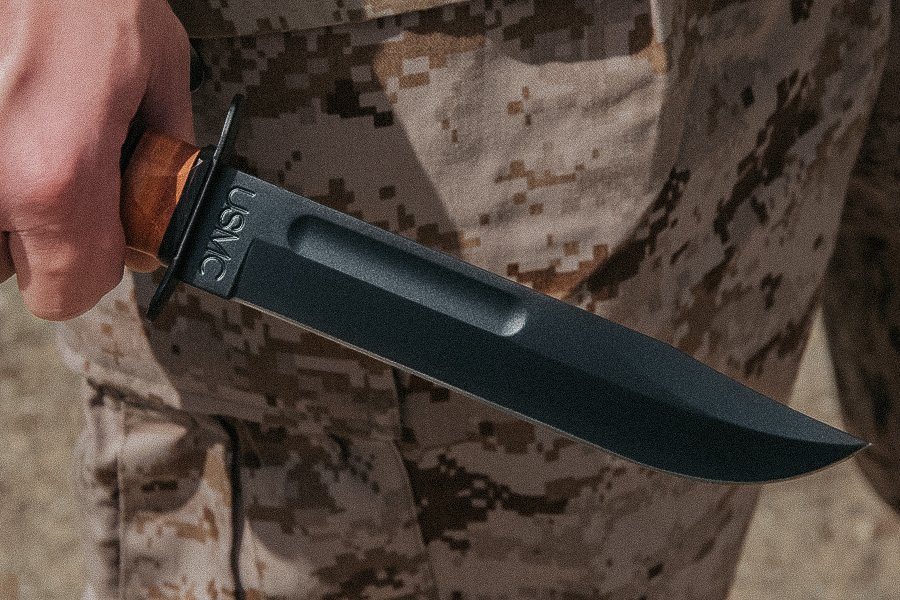
Even though the Kabar is no longer standard-issue, the clip-point utility knife remains relevant. Photo courtesy of Kabar.
It began with an ambush. On the night of April 5, 1967, the men of Charlie Company, 1st Battalion, 9th Marines were patrolling in the vicinity of Con Thien when they came under attack by an entire North Vietnamese Army battalion. In the initial moments of the firefight, most of the Marines were wounded or killed, including the company commander.
Marine Lance Cpl. James Stogner returned fire with his M16. He dropped three men before his rifle was shot out of his hands, destroying the weapon and breaking his nose. Then, armed only with a Kabar knife, he rejoined the fight. Pouncing from man to man with his stainless-steel blade, he killed seven enemy soldiers, including four he stabbed to death as they were torturing a wounded Marine.
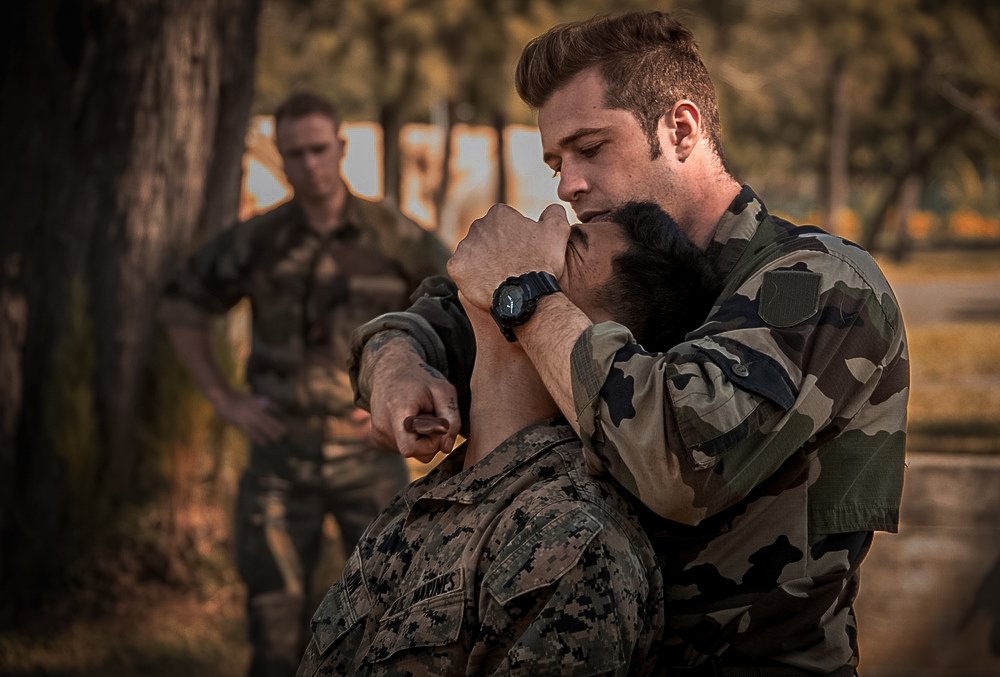
French paratroopers and US Marines practice knife fighting techniques, Aug. 10, 2019. US Marine Corps photo by Sgt. Carlos Cruz Jr.
Stogner earned a Navy Cross that night. While the medal recognizes his extraordinary actions, he wasn’t the first American service member to wield a Kabar to deadly effect in combat. Nor would he be the last. Over the years, and through many conflicts, the Kabar has proven an indispensable weapon in moments of extreme desperation, at times as essential to a soldier’s survival as his rifle or compass.
Related: Death From Afar: How the M40 Earned Its Place Among the Best Sniper Rifles
What Is a Ka Bar Knife?
American service members have been carrying the Kabar since the 1940s. Their ubiquity in famous war photos and action films have made them iconic. The fixed-blade knives feature a 7-inch clip-point blade forged from 1095 Cro-Van steel and a full-length tang encased in a stacked leather handle. The carbon steel that forms the blade is notable for its edge retention, hardiness, and affordability. It is typically carried in a high-quality leather sheath.
Related: Marine Raiders: The Corps’ Only Special Operations Unit
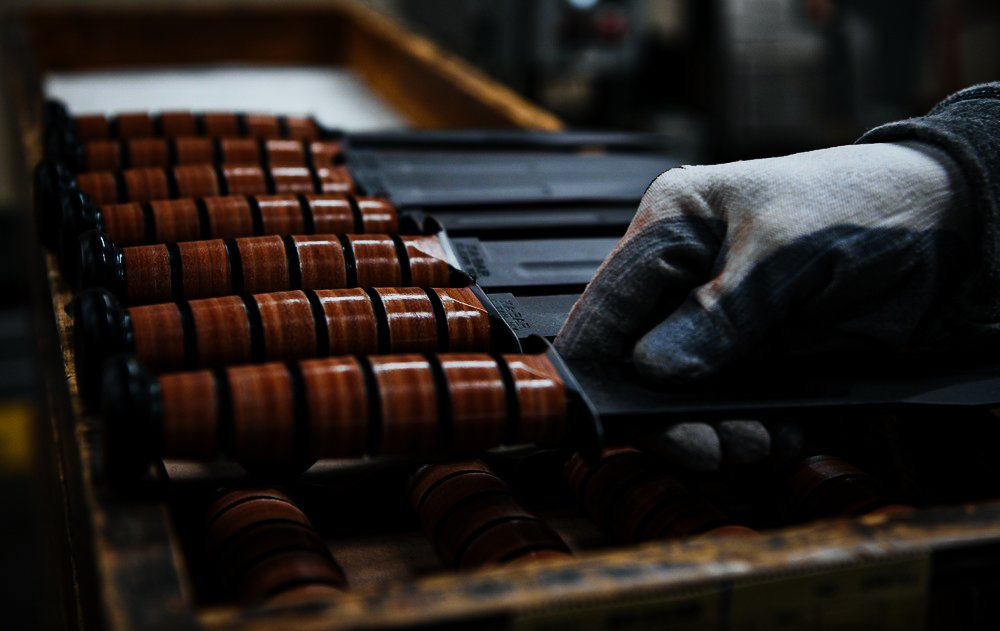
Every Kabar knife is inspected by hand. Photo courtesy of KA-BAR Knives, Inc.
Kill a Bar
Ka bar Knives is a manufacturing company based in Olean, New York. A subsidiary of the Cutco Corporation, the company owes its name to the exploits of an illiterate fur trapper.
In 1923, what was then the Union Cutlery Company received a strange package from Alaska. It contained the skin of a Kodiak bear and a mostly unintelligible hand-scrawled letter. The author of the letter claimed to have killed a Kodiak with his Union Cutlery hunting knife. Or at least, that was the story gleaned from three of the only words that were halfway legible: “kill a bar.”
The president of Union Cutlery Company was so inspired by the letter, he decided to rename the company Kabar, combining “KA” for Kodiak and “BAR” for bear.
Related: Retired Coast Guardsman Kills Kodiak Bear Inside Neighbor’s House With A 12-Gauge
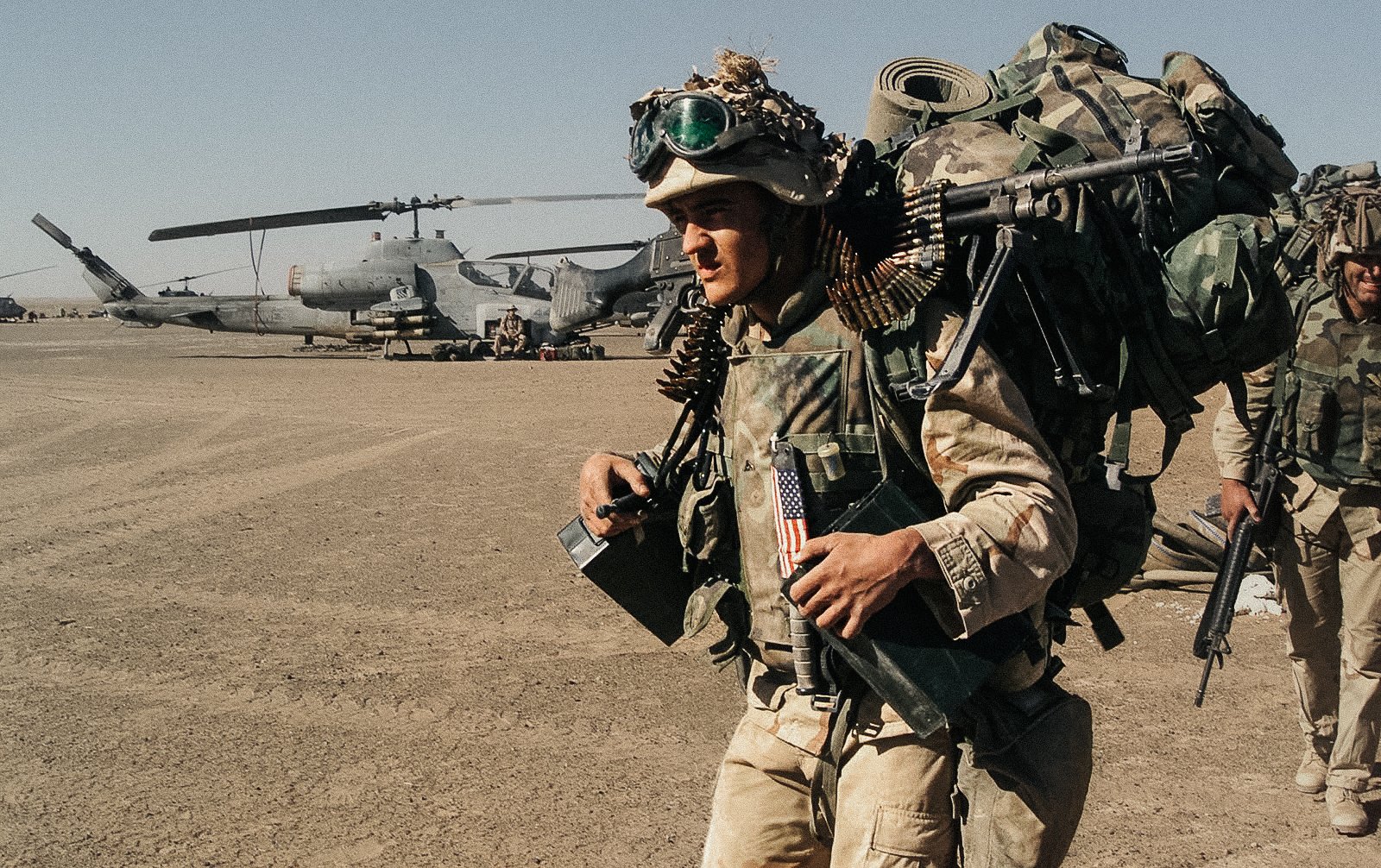
An infantryman from the 15th Marine Expeditionary Unit (MEU) Special Operations Capable (SEC) carries a full combat load, including a Kabar knife, after seizing Forward Operating Base Rhino in support of operation Enduring Freedom in Afghanistan, Nov. 25, 2001. US Marine Corps photo.
C-Rations and Close-Quarters Combat
The Kabar’s reputation as a reliable knife may have been established on the Alaskan frontier, but it was solidified on the battlefields of World War II.
When the United States entered the war in December 1941, most troops were still being issued the Mark I trench knife, which doughboys carried during the First World War. It featured a 6.75-inch dagger-style blade and a brass handle, complete with spiked “brass knuckle” finger loops. For the purposes of mass warfare, the knife design was not ideal. Not only was the bulky brass handle expensive to manufacture, troops complained that the finger loops restricted the types of grips they could use in knife fighting.
While the majority of American service members carried the Mark I, some specialized units, such as the Marine Raiders and other commando groups, were issued stiletto daggers. These too were not ideal. Though effective in combat, the dagger’s thin blade was prone to breaking when used for anything else.
Recognizing the need for a dual-purpose knife, the United States Marines Corps saw a solution in the Kabar. The knife’s comfortable handle accommodates a variety of fighting styles and techniques, while the unique shape of the blade made it good for both stabbing and slashing. Furthermore, the thickness and durability of the blade allowed for it to be used as a prying tool.
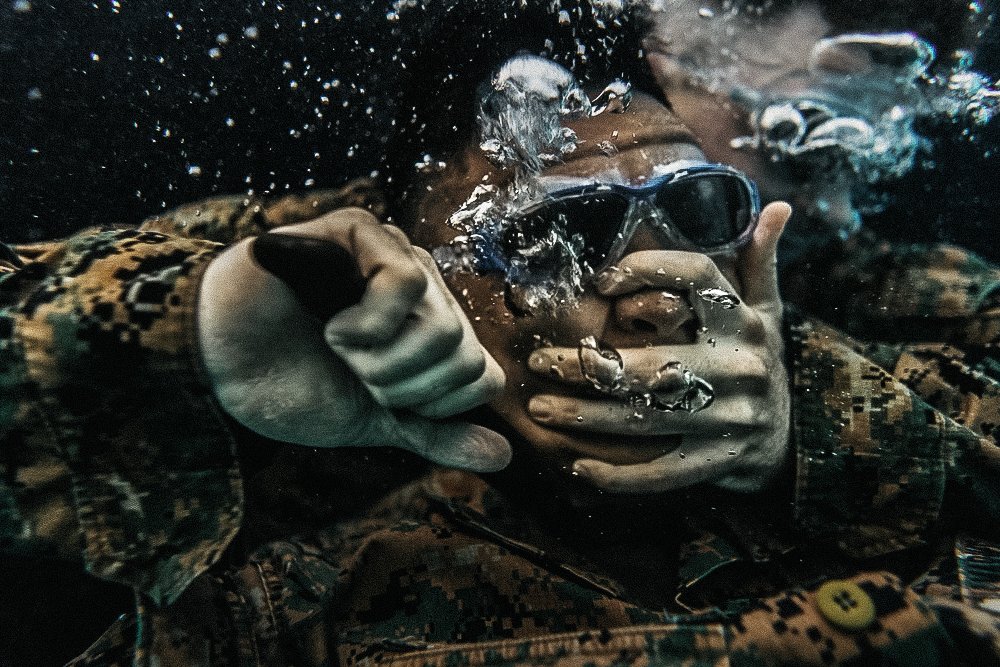
A Marine executes a knife attack during an offensive and defensive technique session at Naval Air Station Joint Reserve Base New Orleans, Aug. 2, 2019. Amphibious by nature, Marines train as they fight, conducting intense physical training exercises to ensure combat readiness in any environment. US Marine Corps photo by Lance Cpl. Preston L. Morris.
The Corps began issuing Kabars to Marines in 1942, and they quickly garnered a reputation for being great utility knives. After hearing Marines sing the Kabar’s praises, the United States Navy followed suit and began issuing the knife to sailors deployed to the Pacific theater.
While Marines and sailors found the utility knife useful for prying open ammo crates and hammering in tent stakes, they also came to rely on Kabars to kill their enemies in close-quarters combat. In his World War II memoir, With the Old Breed, Marine veteran Eugene Sledge recounts what his combat instructor told him the day he was first issued his Kabar:
“Sure, you’ll probably open more cans of C rations than [Japanese soldiers] with this knife, but if a [Japanese soldier] ever jumps into your hole, you’re better off with a Kabar than any other knife. It’s the very best and it’s rugged, too.”
Related: Bring Back These Brutal Marine Knife-Fighting Techniques From World War II
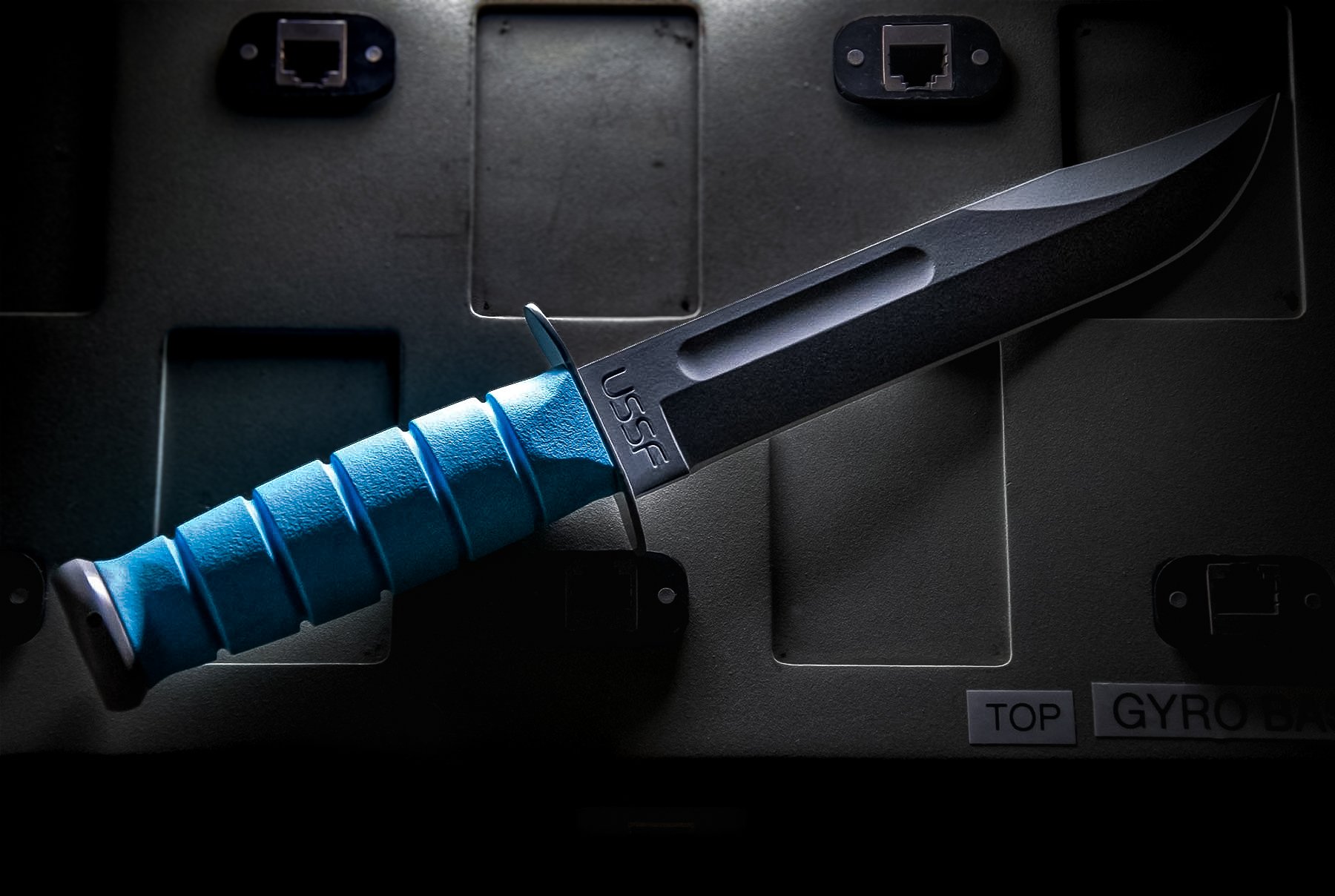
A custom Space Force Kabar. Photo courtesy of KA-BAR Knives, Inc.
Ka Bar Knives Will Never Go Away
Despite its century-old design, the Kabar remains a popular knife among both hunters and service members. Troops today are issued more-modern blades, like the M7 bayonet, yet many soldiers, sailors, airmen, and Marines still opt to carry the Kabar into combat instead.
As an homage to its rich military past, Kabar now manufactures versions of its knife that are specific to each branch of the armed forces, with either USA, USN, USAF, or USMC engraved on the blade. Even the Space Force has its very own Kabar, replete with a baby-blue handle.
Read Next: The M203 Grenade Launcher: Farewell to Infantry’s ‘Little Friend’

Mac Caltrider is a senior staff writer for Coffee or Die Magazine. He served in the US Marine Corps and is a former police officer. Caltrider earned his bachelor’s degree in history and now reads anything he can get his hands on. He is also the creator of Pipes & Pages, a site intended to increase readership among enlisted troops. Caltrider spends most of his time reading, writing, and waging a one-man war against premature hair loss.
BRCC and Bad Moon Print Press team up for an exclusive, limited-edition T-shirt design!
BRCC partners with Team Room Design for an exclusive T-shirt release!
Thirty Seconds Out has partnered with BRCC for an exclusive shirt design invoking the God of Winter.
Lucas O'Hara of Grizzly Forge has teamed up with BRCC for a badass, exclusive Shirt Club T-shirt design featuring his most popular knife and tiomahawk.
Coffee or Die sits down with one of the graphic designers behind Black Rifle Coffee's signature look and vibe.
Biden will award the Medal of Honor to a Vietnam War Army helicopter pilot who risked his life to save a reconnaissance team from almost certain death.
Ever wonder how much Jack Mandaville would f*ck sh*t up if he went back in time? The American Revolution didn't even see him coming.
A nearly 200-year-old West Point time capsule that at first appeared to yield little more than dust contains hidden treasure, the US Military Academy said.












